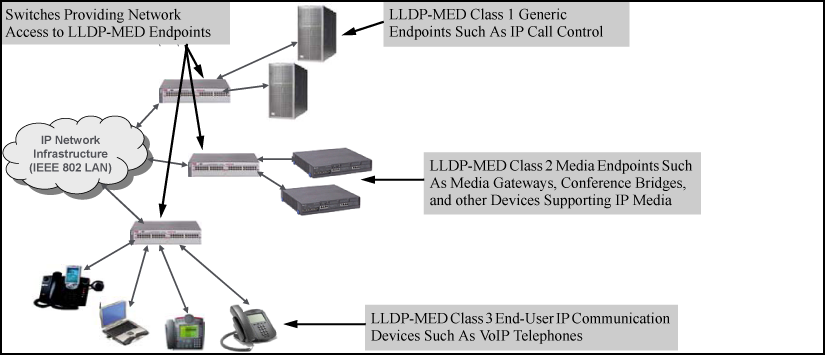LLDP-MED
LLDP-MED (ANSI/TIA-1057/D6) extends the LLDP
(IEEE 802.1AB) industry standard to support advanced features on the
network edge for Voice Over IP (VoIP) endpoint devices with specialized
capabilities and LLDP-MED standards-based functionality. LLDP-MED
in the switches uses the standard LLDP commands described earlier
in this section, with some extensions, and also introduces new commands
unique to LLDP-MED operation. The show commands
described elsewhere in this section are applicable to both LLDP and
LLDP-MED operation. LLDP-MED benefits include:
Plug-and-play provisioning for MED-capable, VoIP endpoint devices
Simplified, vendor-independent management enabling different IP telephony systems to interoperate on one network
Automatic deployment of convergence network policies (voice VLANs, Layer 2/CoS priority, and Layer 3/QoS priority)
Configurable endpoint location data to support the Emergency Call Service (ECS) (such as Enhanced 911 service, 999, 112)
Detailed VoIP endpoint data inventory readable via SNMP from the switch
Power over Ethernet (PoE) status and troubleshooting support via SNMP
support for IP telephony network troubleshooting of call quality issues via SNMP
This section describes how to configure and use LLDP-MED features in the switches to support VoIP network edge devices (media endpoint devices) such as:
IP phones
Voice/media gateways
Media servers
IP communications controllers
Other VoIP devices or servers
LLDP-MED interoperates with directly connected IP telephony (endpoint) clients having these features and services:
Auto-negotiate speed and duplex configuration with the switch
Use the following network policy elements configured on the client port
Voice VLAN ID
802.1p (Layer 2) QoS
Diffserv codepoint (DSCP) (Layer 3) QoS
Discover and advertise device location data learned from the switch
Support ECS (such as E911, 999, and 112)
- Advertise device information for the device data inventory collected by the switch, including:
Hardware revision
Firmware revision
Software revision
Serial number
Manufacturer name
Model name
Asset ID
Provide information on network connectivity capabilities (for example, a multi-port VoIP phone with Layer 2 switch capability)
Support the fast-start capability
LLDP-MED is intended for use with VoIP endpoints and is not designed to support links between network infrastructure devices, such as switch-to-switch or switch-to-router links.
LLDP-MED network elements
